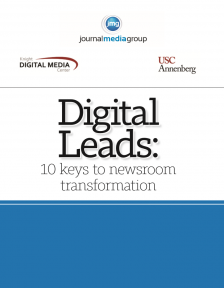“Digital leads” newsrooms push print to the back of the line

Fourth in a series on newsroom transformation to serve digital news consumers.
In a '‘digital leads’’ newsroom, print moves way back to the end of the line. Journalists first create content and engage on digital platforms – phones, web, tablets. Then, the digital content that is most likely to interest print readers is repurposed for the next day’s newspaper.
Sounds simple, right? For many newsrooms, getting there is anything but easy. Even journalists who scoff at the idea of “doing more with less,” are sometimes reluctant to give up familiar tasks.
It can be done. In KDMC’s two-plus years of work with 13 newsrooms that are now part of the Journal Media Group (formerly E.W. Scripps), we found that newsrooms could develop and stay focused on a limited number of priorities once they had connected with news consumers and figured out what topics and what delivery methods were valuable to those consumers. More about our work is detailed in “Digital Leads: 10 keys to newsroom transformation.”
An important aspect of the initiative was that it did not dictate outcomes such as newsroom structure and job descriptions. Instead, it asked the newsrooms to follow a process that helped them shape priorities, plans and practices around the needs of digital news consumers. Structures and roles flowed from their plans.
Here are examples of changes that took place:
Implementation of protocols for breaking news and social media. Newsrooms implemented protocols that included Tweets, alerts, and visuals on breaking stories. The Redding (CA) Record Searchlight began social media interaction with readers during reporting on non-breaking stories. In Washington, the Kitsap (WA) Sun staff began scripting social media campaigns in advance for projects so those elements would not be forgotten.
Reductions in resources devoted to traditional coverage and print production. Treasure Coast (FL) Newspapers, for example, cut the number of pages remade for different print editions and used more wire content. Knoxville developed a system of pre-designing many pages to reduce the workload, an innovation rolled out to several other newsrooms and the company’s Central Desk. The Knoxville (TN) News Sentinel dropped certain features a couple of days a week and developed content-sharing agreements with other news organizations in Tennessee. The newsrooms found that vigorous production of digital content more than filled the next day’s print newspaper. In addition to reductions in print production, editors found a variety of ways to shift staff resources, typically dropping routine stories or assigning them to freelancers.
Converting the traditional afternoon print meeting to a planning session for digital content and engagement for the next day. In Knoxville, for example, planning for digital platforms for the next day became the focus of the main afternoon news meeting while print planning was downplayed in a smaller, separate stand up. Knoxville displays the budget on a large white board in the newsroom that is day-parted to emphasize the need to post at peak times.
Re-creating budgets changed emphasis. Online budget formats were created that call for details of digital elements as well as engagement plans including social media, calls to action, etc., and follow up to make sure those elements are addressed.
Changes in jobs and job descriptions to reflect digital priorities, including shifting more people to roles where their main focus is digital. Treasure Coast, for example, created digital producer positions to drive efforts on digital and social platforms. As well, journalists who embraced digital and social received recognition and plum assignments. “We treated social media interaction at the same level of importance and skill as producing a story or a photo,” Editor Mark Tomasik said.
Staffing was aligned with digital needs. Changes were made in staffing hours to have more people posting at peak times in the mornings and on the weekends.
Restructuring of editing desks. In Kitsap, one local editor became point person for digital/social during the day while a second local editor focuses on planning for digital. “They cross-train and share duties, but having each editor with an emphasis on their role has improved both,” Editor David Nelson said.
In Redding, Editor Silas Lyons used an opening to realign his editing team of four. The managing editor and Lyons took on many of the metro editor functions, enabling Redding to hire a content editor with the expertise to drive digital and social practices into the newsroom.
Moving the furniture. Treasure Coast moved the news meeting to an open area in the middle of the newsroom and invited staff to take part, an indicator of the new culture of participation.
At the Caller-Times in Corpus Christi, “Our digital team is situated in the heart of our newsroom. This helps keep digital first strategies active on the newsroom floor,” said editor Tim Archuleta.
The Memphis Commercial-Appeal had different newsroom departments spread out on different floors. Because of staff reductions, editor Louis Graham was able to move everyone to the main newsroom. The reorganization also placed the digital team adjacent to reporting team leaders.
“The full room provides a sense of renewed energy and helps communication as well,” Graham said. “Editors are pitching in more the help one another. Communication is more effective simply because it’s easier.’’
Previously:
Leadership and culture: Linchpins of digital transformation in the newsroom
Personas: Connecting with digital news consumers
Owning the local news franchise
Next: Learning to set priorities



